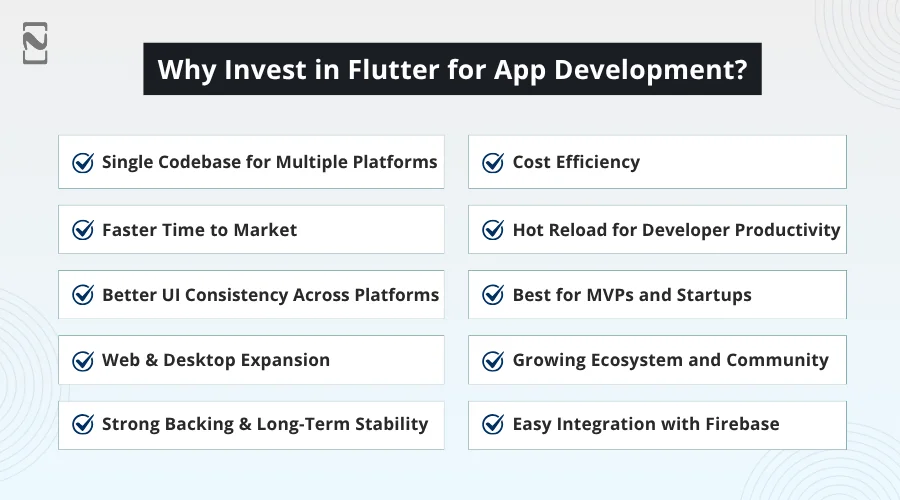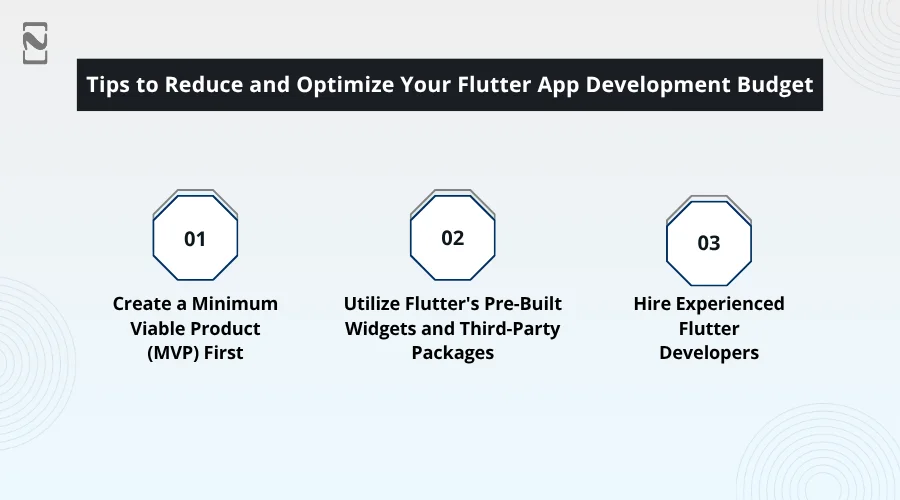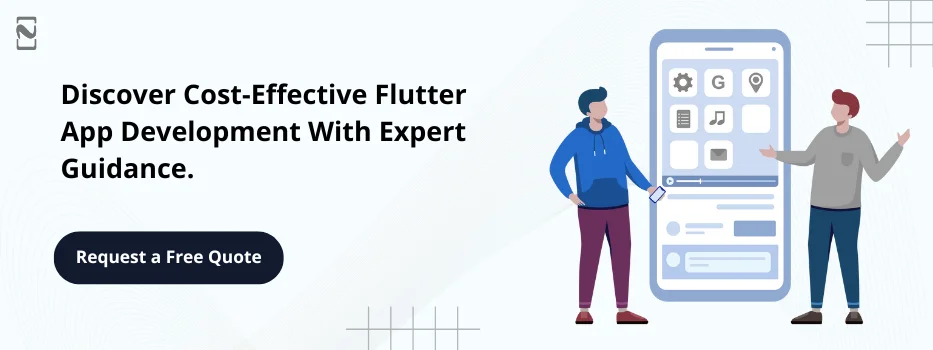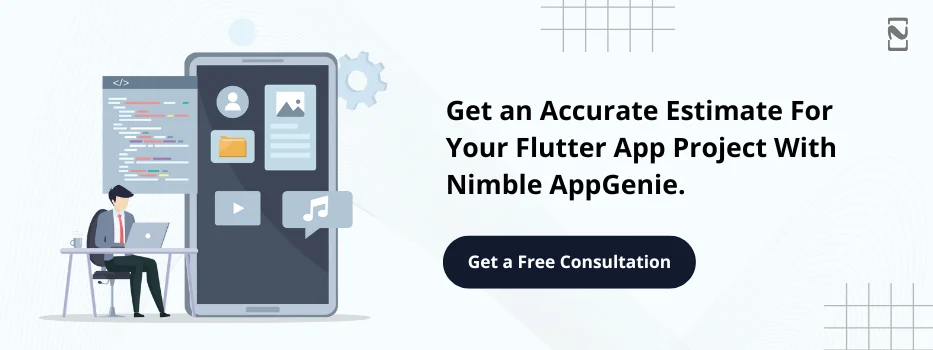Are you planning to consider Flutter for the app development? So, you must be curious to know how much it costs to develop a Flutter app, factors influencing the cost, why choose Flutter, how to optimize the cost, and more.
Well, look no further, as we are here to disclose Flutter app development cost and every significant aspect you need that can help you ease your decision.
But first, what is Flutter? Created by Google, Flutter is an open-source UI software development kit (SDK) that empowers developers to build aesthetic.
Top-performing cross-platform applications that can run on multiple platforms, embracing Android, iOS, Windows, web, macOS, and Linux, leveraging a single codebase.
Simply put, Flutter allows you to write an app once and run it everywhere.
Do you know what developers, agencies, and entrepreneurs expect from a framework they choose? They go with the one that boosts productivity, offers flexibility and scalability, delivers native-like performance, and above all, provides a unified solution for mobile, web, and desktop apps.
At this edge, cost-effective cross-platform app development with Flutter meets every requirement. It’s known for its rich pack of pre-designed widgets, quick and affordable development of MVPs or full-scale products, and the ability to implement pixel-perfect designs easily.
Now, let’s kick off with the reasons why businesses should choose Flutter.
Why Invest in Flutter for App Development?
Here we will discuss the aspects for which you are here: Why choose Flutter for app development in 2025?
Whatever your mobile app development challenges, Flutter has emerged as a savior, being recognized as one of the best frameworks for developing cross-platform mobile apps. Why?

Let’s uncover the top difficulties that Flutter confronts and make the app development process smooth.
1. Single Codebase for Multiple Platforms
Issue: Turning back the clock, if you remember, we had to develop and maintain a separate codebase for Android and iOS, sometimes also for web and desktop.
Flutter’s Role: Flutter let us write one codebase and make it run on multiple platforms, which leads to reduced app development time, maintenance costs, and bugs.
2. Cost Efficiency
Issue: Obviously, it’s expensive to hire two different teams for Android and iOS mobile app development. Above that, project management workload also increases as one needs to manage two separate projects.
Flutter’s Role: Only one development team is required, which helps in cost-cutting, and less code means fewer bugs, which again lowers QA overhead.
3. Faster Time to Market
Issue: Native app development demands more time because of specific development cycles and testing that depend on the platform you choose.
Flutter’s Role: Flutter comes with a unique feature, hot reload, which paces development and debugging. Besides, Flutter’s pre-built and customizable widgets speed up UI creation, and a shared codebase allows centralization and reuse of code.
4. Hot Reload for Developer Productivity
Issue: Do you find it frustrating to wait for builds or restart the application for small changes, as it slows development? Not to fret when Flutter is here.
Flutter’s Role: One more time, Flutter’s hot reload lets developers perform real-time changes while holding the app state. So forth, you can accelerate experimentation and error correction.
5. Better UI Consistency Across Platforms
Issue: Well, it’s tough to achieve a consistent look and feel on different platforms with native development because of the specific components of every platform.
Flutter’s Role: Flutter frees you up from this, as it has its own widget set and rendering engine. This states that you can get 100% UI consistency across distinct platforms, even with complicated designs.
6. Best for MVPs and Startups
Issue: Startups are usually under pressure because of limited operating budgets. Thus, they look for rapid product idea testing at low cost before scaling.
Flutter’s Role: The cross-platform app development framework takes control of building and releasing Android + iOS MVP from only one codebase. Ahead, it quickly iterates, reaping the rewards of again, ever-useful Hot Reload and flexible UI tools that prove to be cost-effective and scalable.
7. Web & Desktop Expansion
Issue: Traditional development needs multiple tech stacks for creating platforms across web, mobile, and desktop.
Flutter’s Role: Flutter pops up with multi-platform power that provides Flutter web and desktop (macOS, Linux, and Windows) support. The same codebase and architecture allow Flutter to provide true cross-platform development potential.
8. Growing Ecosystem and Community
Issue: Usually, new or you can say niche-specific mobile app frameworks lack third-party packages, community support, learning resources, and documentation. Resultantly, it makes the Flutter app development slow and fails to find solutions to problems.
Flutter’s Role: Flutter appears with its rich set of packages and plugins, extensive documentation, and useful forms. Apart from that, official Google support, Flutter Engage, and more such events strengthen the framework. Such systematic progress reinforces developers to share knowledge, find solutions, and boost app development.
9. Strong Backing and Long-Term Stability
Issue: Doubtlessly, developers wouldn’t prefer investing time in frameworks that are anticipated to become obsolete, unsupported, or abandoned, since it can raise the risks for long-term project success.
Flutter’s Role: Google created Flutter and itself leverages its power internally for various products. So, because of this powerful corporate support, the mobile app framework is more likely to ensure its never-ending development, innovation, and updates. Plus, Google has already crafted a precise plan and commitment to Flutter’s outlook, which makes it a trustworthy and stable selection for prolonged projects.
10. Easy Integration with Firebase
Issue: Being a developer or enthusiast, you would also demand for a reliable backend for analytics, push notifications, database, authentication, and more. But undeniably, integrating such features manually can be error-prone and even time-consuming.
Flutter’s Role: With Firebase, a mobile and web application development platform of Google, features integration is flawless when you choose Flutter. It offers official Firebase plugins for this framework that empower developers to swiftly implement backend services. Consequently, this paces up the development, guarantees compatibility, and eases feature-packed applications deployment.
What is the Cost of Flutter App Development?
In this section, we will attempt to estimate the Flutter app development cost. Broadly, Flutter development pricing depends on distinct factors like app complexity, UX/UI design, etc. (we will discuss ahead in this post).
However, roughly the Flutter mobile app cost estimation ranges between $50,000 to $200,000+ (complex ones).
You can try any Flutter cost calculator to get an idea about the cost. But it would be better to delve deeper, considering every factor impacting the pricing heavily.
Factors Affecting the Flutter App Development Cost
Before you finalize a Flutter development budget, let’s scrutinize the factors influencing the cost of Flutter app development.

1. App Complexity & Features
Considering the primary Flutter app cost drivers, the complexity of its functionality and the number of features come to the surface.
With the increasing app features, the app complexity also surges depending on the app type.
Estimated Cost Of Flutter App Based On Features And App Complexity:
| Level of Complexity | Core Features | Estimated Cost Range |
| Simple App |
|
$20,000 – $40,000 |
| Medium Complexity |
|
$40,000 – $60,000 or more, depending on region. |
| Complex / Feature‑Rich App |
|
$60,000 – $150,000+ (could be much more depending on scale) |
Note: The cost to develop a Flutter app mentioned above may fluctuate depending on your project level and requirements.
2. Development Team and Location
Another cost-impacting factor is the location of the development company you are hiring.
Let’s take an example – if you hire Flutter developers from India or South Asia, it will cost less compared to a Flutter app development team from the UK, US, Australia, and other such regions.
Flutter App Developers’ Hourly Rates Analysis
| Region / Country | Developer Rates Per Hour (USD) |
| North America | $100-$250+ per hour |
| Western Europe | $50-$180 per hour |
| Eastern Europe | $25-$120 per hour |
| South America | $25-$120 per hour |
| Asia (India) | $20-$50 per hour |
Note: Hourly cost to hire Flutter app developers notably vary based not only on location, but also on their experience level.
Hiring Model and Team Structure
You can choose from the below that best suits your project needs and budget.
- Freelancers: This is one of the most cost-effective options, but it comes with a few drawbacks, like a lack of commitment, missed deadlines, and risk of compromised quality.
- In-House Team: Well, this is the most expensive option as it comes with fixed costs for benefits, salaries, and overhead.
- Outsourced Flutter App Development Company: Best of all, as it offers a team of experts and cost-effective solutions, specifically if you choose regions with lower labor costs.
3. Design and User Experience (UI/UX)
The UI/UX design of the app also determines Flutter app development costs; if it’s simple with basic designs, it will cost you less, but if you choose to craft a highly intuitive app, it will definitely cost you more.
Flutter App Development Cost Breakdown Per App Design
| Design Complexity | Type of Interface | Estimated Cost (USD) |
| Basic UI | Simple interface with standard Flutter components and templates. | $5,000 to $10,000 |
| Custom UI/UX | Branded interface with custom flows and layouts. | $10,000 to $15,000+ |
| Advanced Custom Design | Complex and high-end interfaces | Exceed $30,000 |
4. Backend Development
Backend development strengthens key features, such as data storage, APIs, user authentication, and business logic.
Leveraging services like Firebase helps to diminish costs and accelerate app development. Talking about a custom backend, it’s more flexible, which increases cost and time.
With the backend complexity, the Flutter app pricing increases by about 30-50% of the total development expenses.
Flutter Backend Development Cost Estimates
| Backend Scope | Typical Use Case | Estimated Cost (USD) |
| Basic (using Firebase/Supabase) | Auth, Firestore/Realtime DB, minimal logic | $1,000 – $3,000 |
| Moderate (custom API + Firebase) | Auth, image uploads, some logic, notifications, dashboard | $3,000 – $7,000 |
| Advanced (custom backend) | REST/GraphQL API, business logic, dashboards, admin roles, analytics | $8,000 – $30,000+ |
5. Third-Party Integration
This cost-influencing factor, third-party integration, incorporates Flutter app integration with external services like maps and payment gateways.
Although such integrations boost app functionality, they add to the time and testing required, thereby contributing to the mobile app development cost.
With the increasing integration needs, the complexity and overall Flutter development budget increases.
Third-Party Integrations Cost Breakdown for Flutter
| Integration Type | Examples | Estimated Cost (USD) |
| Payment Gateway | Stripe, Razorpay, PayPal | $500 – $2,000+ |
| Map & Location Services | Google Maps, Mapbox | $300 – $1,500 |
| Social Media Login | Google, Facebook, Apple Sign-In | $200 – $800 per provider |
| Push Notifications | Firebase Cloud Messaging, OneSignal | $300 – $1,000 |
| Analytics Tools | Google Analytics, Mixpanel, Firebase Analytics | $200 – $800 |
| Chat / Messaging | Twilio, Sendbird, Stream.io | $1,000 – $3,000+ |
| Video / Audio Streaming | Agora, Zoom SDK, Vimeo | $1,500 – $5,000+ |
| CRM / Marketing Tools | HubSpot, Mailchimp, Intercom | $500 – $1,500 |
| In-App Purchases | Google Play Billing, Apple IAP | $500 – $2,000 |
| File/Image Upload & Storage | Cloudinary, AWS S3, Firebase Storage | $300 – $1,000 |
Note: These are only one-time integration cost estimates; some of the services may demand ongoing costs.
6. Testing & Quality Assurance (QA)
Mobile app testing is non-negotiable and needs to be performed across different devices, considering distinct scenarios.
It embraces manual testing, automated testing, bug fixing, and cross-platform testing. This surely lets us witness the ultimate user satisfaction and stability in the Flutter app.
It may cost you more, but also ensure comparatively less post-launch issues.
7. Post-Launch Maintenance and Updates
Your job doesn’t end after Flutter app development. Instead, actual work starts only after the launch.
You should regularly conduct bug fixes, OS compatibility modifications, feature updates, and SDK upgrades.
If you overlook this, it may compromise app security and hamper its functionality. Per year, app maintenance may take 15-20% of your cross-platform app development cost.
8. Deployment & Store Fees
App launch includes setting up Play Store and App Store listings, creating screenshots, app icons, and writing descriptions.
You need to ensure your app passes the review and gets approval. Besides, you should have a developer account to address rejections or resubmissions if needed.
App Deployment and Store Fees Analysis
| Item | Cost Estimate (USD) |
| Apple Developer Account | $99/year |
| Google Play Console | $25 (one-time) |
| Deployment & Publishing Work | $300 – $1,000 |
| App Store Rejection Handling | $100 – $500 (per issue) |
9. Platform Support & Multi‑Device Strategy
Flutter allows Android and iOS app development from a single codebase, but if you want desktop, web, or tablet optimization, it adds more layout, design, and testing complexity.
10. Security and Compliance
Apps must comply with applicable regulations, like HIPAA, GDPR, and ensure secure APIs, data encryption, and role-based access control, especially if your app handles sensitive data.
Estimated Cost of Security and Compliance
| Security Level | Details | Cost Estimate (USD) |
| Basic Security | Secure login and encrypted data | $500 – $2,000 |
| Medium | Data encryption, secure APIs, and privacy settings | $2,000 – $5,000 |
| High (Regulated Industries) | Full GDPR/HIPAA compliance, audit logging, legal checks | $5,000 – $15,000+ |
Hidden Costs of Flutter App Development
Apart from the obvious expenses of Flutter app development, some hidden costs are usually missed. Ignoring these may hinder your progress during deployment, updates, scaling, and long-term operations.

1. App Store Rejections & Resubmissions
You can’t be sure about app rejections, as even a well-developed application may face this because of privacy issues, UX/UI violations, or unsupported features.
Next, to mend this, it demands code rewriting, design fixing, or extra documentation.
Hidden Cost: $300 – $1,000+ per instance
2. UI/UX Revisions During Testing
During user testing, you can predict changes in initial designs. Such modifications may seem minute, but they lead to a notably increased workload for designers and frontend developers.
Hidden Cost: $500 – $2,000+
3. SDK/Plugin Updates & Compatibility Fixes
With time, Flutter and its plugins also evolve. Even after a few months, your code may become unstable or may break, demanding app developers to rewrite features, update dependencies, or even refactor code.
Hidden Cost: $500 – $3,000+ per year
Flutter vs Native Development: Cost Perspective
However, at this point, you have almost every detail relevant to the Flutter development budget for which you came here.
Still, you might be finding yourself in a muddle about which development approach you should go for, Flutter or Native.
Considering their strengths, both are leading the app development market, but cost is the only deciding factor that will ease your decision-making.
Let’s get clear thoughts about Flutter vs native app development cost:
| Aspect | Flutter | Native (iOS + Android) |
| Codebase | Single codebase for both platforms | Separate codebases |
| Development Cost | 30-40% cheaper due to shared code | It’s higher due to two separate teams and duplicated work |
| Time to Market | It is faster because you need to build once and can deploy everywhere | Slower, as you need to build and test apps separately for each platform |
| Team Size | Only one Flutter developer (or team) | Minimum of two native developers (iOS + Android) |
| Maintenance Cost | It is lower as you have to maintain one codebase | Higher as you need to perform separate updates and bug fixes |
| Third-Party Libraries | Provides good support, but restricted in some edge cases | Mature ecosystem with platform-specific libraries |
| Initial App Cost Estimate | $10,000 to $50,000+ (depending on features) | $20,000 – $100,000+ (iOS + Android combined) |
| Ongoing Costs | It’s lower due to unified development | Doubled for QA, maintenance, and updates |
Tips to Reduce and Optimize Your Flutter App Development Budget
Developing a top-quality Flutter app doesn’t cost you an arm or a leg. What you must do is plan smartly and make strategic picks to control the cost while delivering the expected user experience.

Below are some proven tips to reduce and optimize Flutter app development costs.
1. Create a Minimum Viable Product (MVP) First
If you are already in the development field or an enthusiast, you might know that while focusing on solving the main pain points of the users, starting with only core features will help you launch rapidly without spending much.
This approach will also help you incorporate development time and cost. Early idea validation helps you benefit from iterative app improvement.
Estimated Cost Reduction: About 30 to 40% by avoiding feature stuffing.
2. Utilize Flutter’s Pre-Built Widgets and Third-Party Packages
As we read earlier in this post, ready-made widgets and community plugins can diminish the need for custom development.
Despite the requirement of creating common features from scratch, you can speed up development and mitigate bugs just by leveraging these resources.
Estimated Cost Reduction: Up to 20 to 30% by reusing existing components.
3. Hire Experienced Flutter Developers
It is best to hire Flutter developers who have the expertise and experience required to write clearer and efficient code.
They also hold the caliber to predict possible challenges and implement ideal practices that save you from costly debugging and rework later.
Estimated Cost Reduction: Can save around 15-25% on development and maintenance.
Why is Nimble AppGenie the Right Choice for Flutter App Development?
Outshining the competitors as a leading Flutter app development company, Nimble AppGenie surges with a combination of technical expertise and a client-centric approach to deliver unique mobile applications.
Key Highlights of Hiring Nimble AppGenie:
- Proven Expertise and Experience
- Comprehensive Tech Stack
- Agile and Efficient Development Process
- Tailored Solutions Across Industries
- Industry Recognition
Still not convinced? Let’s open our trump cards!
Real-Time Case Study: Flutter App for a Streaming Platform
Challenge: A client required the app development team to build a mobile app for music and audio streaming.
Special Demands:
- Fast development
- Control over lasting maintenance costs
- Consistent user experience
Solution We Offered: Our developers choose Flutter to meet cost-platform efficiency. Our services included:
- Single codebase for both platforms.
- Pre-built widgets to accelerate UI development.
- Integration of custom audio streaming APIs.
- Agile methodology for iterative development.
- Firebase implementation for cloud functions and authentication.
Outcome Achieved:
- 30-40% faster app delivery
- 35% reduced ongoing maintenance costs
- Consistent UI and performance
- Simultaneous app launch on both app stores.
Note: Case study showcases a real Flutter app project, but client’s name is kept hidden for confidentiality.
We hope this case study answered all your queries and confusion you had before deciding to hire Flutter app developers from Nimble AppGenie.
Contact our experts and know the exact Flutter app development cost!
Wrapping Lines
Now you know how much does it cost to develop an iOS and Android app with Flutter.
Next, you have to choose on which mobile app framework you can pick to win hands down in this competitive and ever-evolving app development industry.
You should prioritize partnering with a trusted mobile app development company that can offer you precise Flutter app development costs with required consultation to kickstart smoothly and end up building a successful app that can thrive in the market.
Get in touch with Nimble AppGenie today and know how much does it cost to build an app with Flutter?
FAQs
Yes, some hidden costs prospects are:
- App store submission and resubmissions
- Licensing fees for fonts, images, or APIs
- Legal compliance
- App Performance Optimization or post-launch revisions
The main factors that increase the Flutter app development cost are:
- App complexity & number of features
- Custom UI/UX design
- Third-party integrations (APIs, payment gateways, etc.)
- Backend development and database setup
- Ongoing maintenance and updates

Niketan Sharma, CTO, Nimble AppGenie, is a tech enthusiast with more than a decade of experience in delivering high-value solutions that allow a brand to penetrate the market easily. With a strong hold on mobile app development, he is actively working to help businesses identify the potential of digital transformation by sharing insightful statistics, guides & blogs.
Table of Contents






No Comments
Comments are closed.